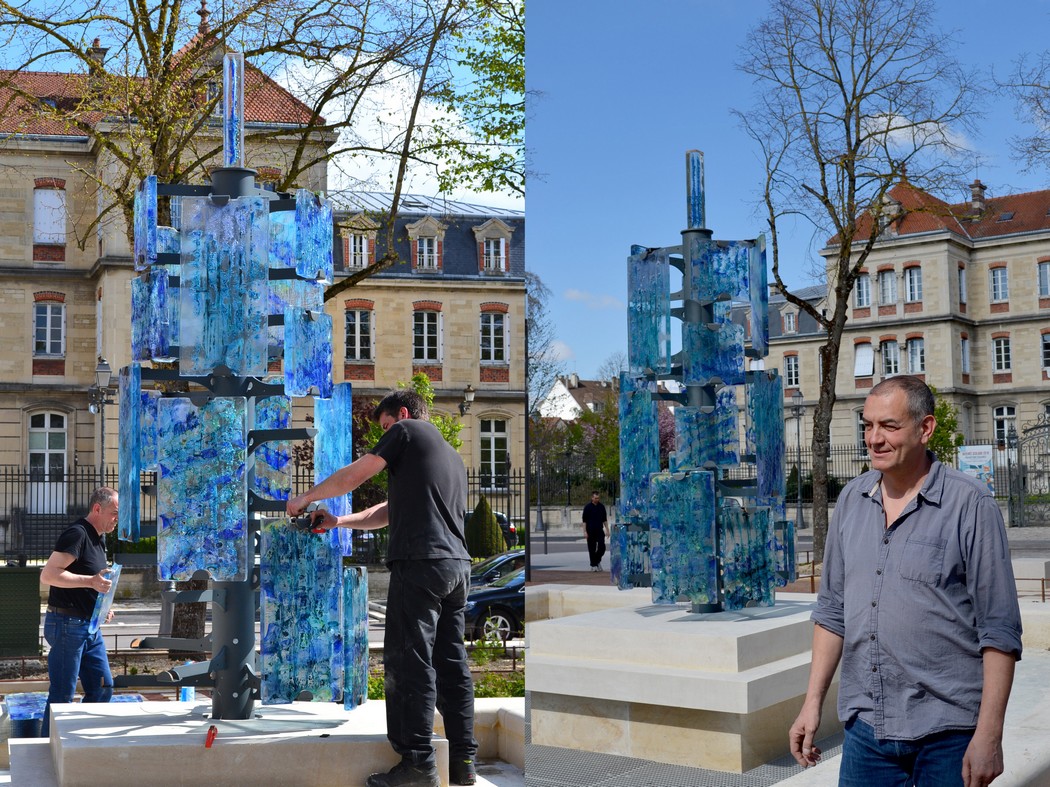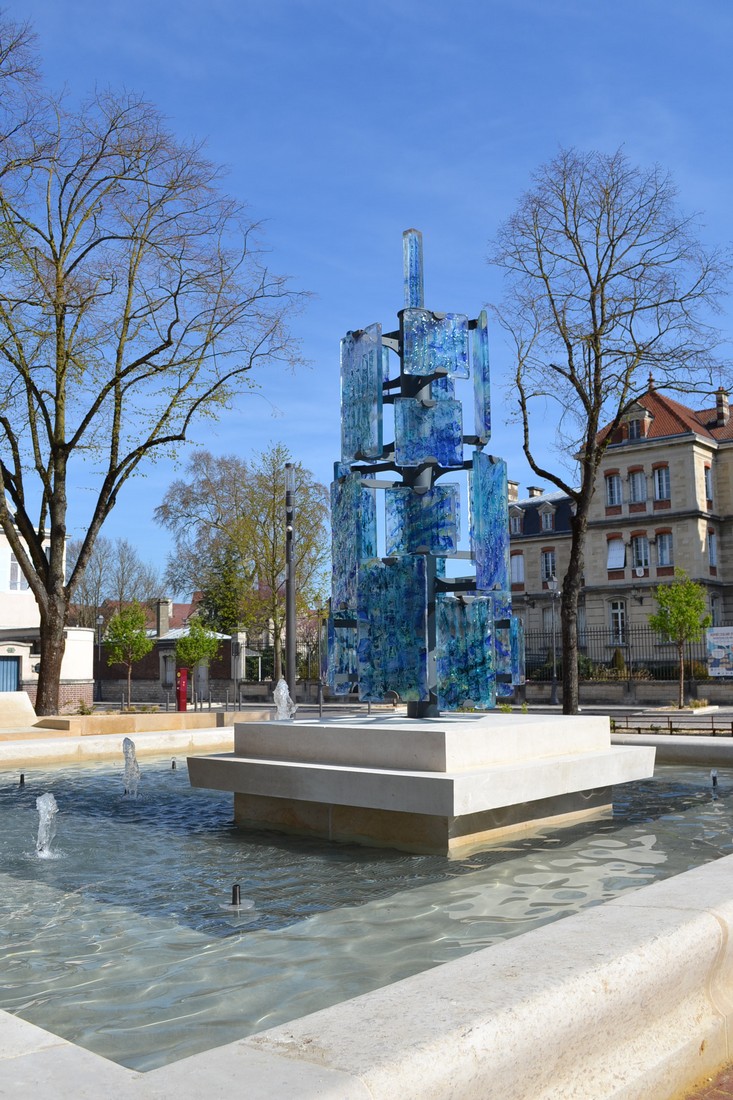About
Elevation, blue water lilies
A monumental glass sculpture Place de la Tour, Troyes
A large glass sculpture is installed on Place de la Tour, in a fountain with a square basin. Weighing 500 kg of glass, the steel structure supports 20 light-permeable glass panels and is topped by a crystalline spire. In collaboration with Didier Duchêne, Compagnon du Devoir and manager of the CMD² metalworks in Estissac, glass artist Jean-François Lemaire created what is undoubtedly France's first large-scale glass urban art sculpture. The work, which expresses several themes using the vocabulary of contemporary art, was commissioned by the city of Troyes. The themes that the artist and the city had agreed to develop by spring 2018 relate to history, water and the color blue. Also at the root of the project is a tribute to the painter Claude Monet, who so often painted the reflections of light on rivers, ponds and streams.
Élévation, bleus nymphéas took a year to complete. Jean-François Lemaire conceived the project and created, then fired and refired (6 to 10 days) several dozen thick glass panels, each a work in itself. These panels have a variety of textures and a dominant blue color, produced by fusing metal oxides. Once polished and re-cut if necessary, they were tested outdoors for many months for their resistance to the elements and thermal shock. Numerous tests were also carried out in the workshop during the installation of the steel structure. Indeed, the creation of a monumental glass sculpture installed outdoors in a public space brings with it constraints not imposed by smaller works installed indoors. The same is true of glass's usual uses in the building industry. Didier Duchêne considers that working with Jean-François Lemaire was an enrichment in the approach to the glass/metal relationship, "a real laboratory, insofar as the project was very unusual and the quantity and variety of questions to which we had to find the right technical answers was very great". This has now been achieved, and the work has returned to its double Burgundy stone base in the heart of Place de la Tour.
The elements of meaning and their transpositions: history, water, mills, books.
The location chosen by the town is an emblematic site, restored to its convivial vocation through redevelopment. It lies just in front of the former monumental gateway to the first castle of the Counts of Champagne, demolished in the 19th century. In the Middle Ages, this gateway saw the passage of prestigious intellectuals, kings, the first Knights Templar and the brilliant court of the Counts. Élévation, bleus nymphéas is, in its own way, a joyful, playful gateway accessible to all, in dialogue with the now-invisible gateway to the vanished château.
The Place de la Tour was also close to several waterways, equipped with water mills. Indeed, with the omnipresence of water in and around the town from the Middle Ages onwards, these installations multiplied and for centuries played a major role in its economy. A wealth born of water. Jean-François Lemaire has made water a major
a major theme in his work. Like the water of the Seine, the rus and the biefs, the glass panels express depths, opacities and reflections, the movements of aquatic life and the rustle of the wind on the surface. It's as if "slices" of water had been taken, immobilized and installed on the metal branches by a magical gesture, and given new life.
In the same way, the steel structure of the work can be seen as the camshaft of a poetic mill, whose wheel we would operate by turning around the fountain, on an imaginary water path. If this path is horizontal, the movement transmitted is vertical, and this is the whole point of Élévation, bleus nymphéas, which encourages us to grow, to turn towards knowledge, but also towards impressions, clouds, the blue of the sky captured in the panels and in the spire of pure transparency that crowns the whole.
The contents of the panels are also revealed to those who wish to see them, according to the variations in light, grey skies, clear skies, night lighting. What seems hostile and silent in the morning will come alive at midday, in full sunlight, revealing unsuspected worlds of color and veils. And so, as we read and learn, understanding dawns: what had previously eluded us suddenly becomes clear. Pages of glass, pages of books: here, elevation comes through play, through impressions and, above all, through frequent visits, for it takes time to "turn the wheel" and allow oneself to be questioned, altered and convinced by the thousand and one signs that the work offers us.
Monet and the "Blue Water Lilies
Let us conclude this presentation with a tribute to Claude Monet. This immense artist painted at the crossroads between what the eyes really see and what the heart can feel. Morning, noon, evening... Cathedral, mill, pond or soft corolla, what mattered to him was capturing time, the changing reflections of light on stone, water or flower. The blue of the water lilies was then that of the meteors in the mirror of Giverny, married with the memories and feelings of the creator. Monet thus opened the way for all artists to listen to and express their own perceptions, to convey rare and subtle emotions beyond form.
With a different vocabulary, the blue panels of the sculpture Elevation, water lily blue, reflecting or letting through the light, also speak to us of water, time and transmission. These are their strongest messages. But there's also the pleasure of looking at the reflections, exploring the steel structure, wandering around the pool, discovering details, looking for signs and reminders. These are all subtle messages that engage us as we set in motion the poetic movement that makes us, for the space of a moment, citizens of this work and of our own dreams.
Catherine Divet
Rate
Gratuit


